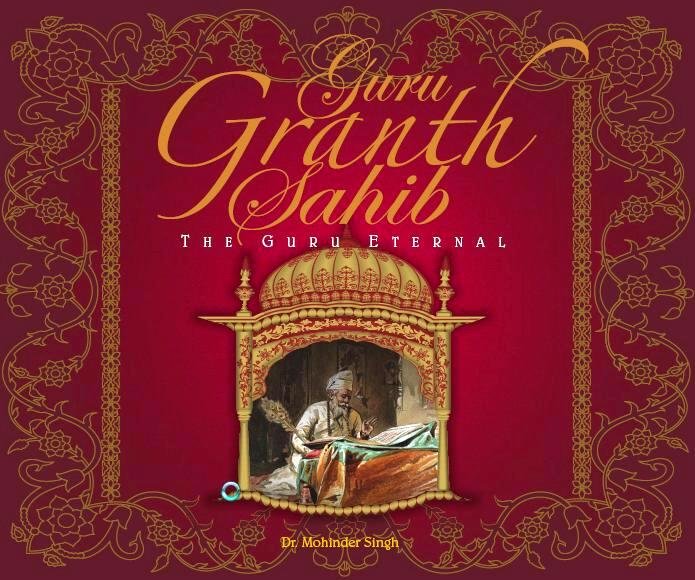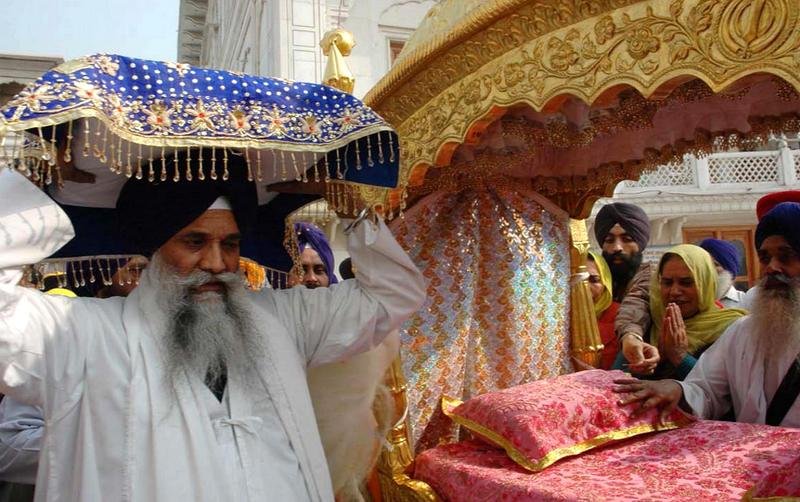
To my mind this the finest example of a coffee table book but my heart rebels at such a moniker for it. It is much, much more than that; it is indeed a labor of love, with a lot more to teach us than simply being delightful eye-candy.
The year 2008 marks exactly 300 years since Guru Gobind Singh, the Tenth Sikh Master, invested the almost 1400 page tome that was the Adi Granth as the Guru Granth – eternal living Guru of the Sikhs and the repository of their entire spiritual heritage.
Sikhism is a young religion. The period of its founder, Guru Nanak, parallels that of Reformation and Renaissance, and an era that saw great ferment of ideas in the world. And we do live in interesting times: we have experienced many important commemorations in a very short span. The 500th anniversary of Guru Nanak’s birth in 1969; tercentenary of Guru Gobind Singh’s birth in 1966, and of the Khalsa in 1999; four centuries of the Adi Granth in 2004; andnow 300 years of Guru Granth
The book opens with a commendatory remark by Prime Minister Manmohan Singh of India. He pointedly notes that "The vision of Guru Granth Sahib embraces the whole of humanity – its concerns are universal and transcend geographical and linguistic boundaries”
An Introduction by Dr. J.S. Neki, that is both rigorously scholarly and movingly devotional, sets the tone for this magnificent tributeto the Guru Granth. In it, he very aptly quotes Arnold Toynbee, the celebrated historian, as saying, "In the coming religious debate, the Sikh religion and its scripture, the Adi Granth, will have something of special value to say to the rest of the world."

Neki is at his most inspiring here when exploringthe nature of revelation in the mystical experience that is common to the world's great religions. He reminds us that Sikhism makes no claims to exclusivity in revelation, and that the doctrinal emphasis unchangingly remains on the universality of the divine. He goes on to note that Guru Granth remains perhaps the first, if not the only, sacred scripture that was compiled by the founders of the faith.
Significantly, Guru Granth contains the writings of 36 authors but only six of the ten Founder-Gurus. Three are Muslim holy-men, 12 are Hindus (5 Brahmins, 3 Rajputs, 4 low-castes);4 honored Sikhs, and 11 are minstrels and bards (Bhatts). This makes Guru Granth a monumental interfaith scripture, and thus, unique. Another highly unusual feature is that most of the poetry in Guru Granth is set in the notes of classical Indian musicology. This then makes music an inseparable part of and integral to Sikh worship, where Word is the revelatory medium.
Seven inspiring chapters follow the Introduction.
The first chapter, Sikh religion & the Sikh Scripture, explores the life and enlightenment ofNanak, and follows that with a brief summation of his message, including Japjee, the primal creed, and the institutions he founded, including keertanas well as the community kitchen (langar). It then reminds us that “Of all religions the best religion is to utter the holy name with love and do good deeds.”
The next chapter, From Pothi to Guru Granth Sahib, traces the colorful history and compilation of the Adi Granth in 1604, as well as its contributors and how they came to be included.
The following chapter on Installation of the Adi Granth in the Harimandir Sahib recapitulates some interesting history: how, in 1604, Guru Arjan escorted the Adi Granth (the precursor to Guru Granth) with great ceremony, respect and adoration to the Harimander. It is a protocol that is followed to this day. Doors to the Harimandir open at 2:30 AM to the sounds of keertan. Guru Granth is ceremoniously escorted in from the Akal Takht at 4:30AM. Keertan continues all day; finally at 10:30 PM Guru Granth is carried back to the Akal Takht for the night. In a sense then, Guru Granth holds court all day for its disciples.
I found the fourth chapter -- Contributors of Guru Granth Sahib – extremely enlightening. It summarizes very nicely what we know of the lives of those whose writings were honored by inclusion. We know so little of so many bhagats and bards. We know that the writings of these Hindu and Muslim contributors are also set to ragas, but who did the setting? Was it Guru Arjan or was it the author, even though several of the authors preceded the Gurus by a considerable period? Istill wonder -- this monumental work provides no hint or answer.
Important Hukumnamas & Nisans comprise the next chapter. The word Hukumnama means an edict or command. Occasionally in response to a particular purpose or need, the Guru would issue a letter, like an encyclical, to the congregation, which would respect and obey it like a royal edict. Many genuine hukumnamas have survived the ravages of time and they provide a critical window into Sikh history and religion of that time. Obviously they are not included in Guru Granth but some of these, including one by Mata Sahib Dewan, are explored in this chapter.

Obviously, for Guru Granth to become incorporated into our lives, it is necessary that we understand the Word. But the Word was written over 300 to 500years ago. Also, the languages in Guru Granth are many and there are myriad references to Hindu and Islamic mythology. The next chapter, Interpretations and Translations of Guru Granth Sahib, focuses on the many translations and expositions that are now available in numerous languages, such as French, German, Urdu, Hindi, and others. In Punjabi there are many. Even in English there are more than one, starting with first attempt by Ernest Trumpp that was not well received.
Some historical hand written recensions of Guru Granth exist, but India does not yet have the tradition of preservation and restoration of such material. The last chapter of the book, Conserving Rare Guru Granth Sahib Birs, focuses on the need to digitize and preserve our heritage. The need is critical; the time for action is now. The author, Mohinder Singh, has taken the lead in initiating the process of digitization of our treasured manuscripts; he deserves to be commended and supported.
I have devoted ample space to summarizing and presenting to you the contents of the written chapters. They are but a smallpart of this work, however. The most eye-catching and significant portion ofthe contents is the art - it cannot be described, only experienced. I have not seen anything better.
William Baker’s photograph of the Harimandir taken in 1864-65 is absolutely stunning, as is William Simpson’s 1860 water color of the Akal Takht. The credits include some of the legendary photographers and artists, including Raghu Rai, Hardev Singh, Malkiat Singh, Sondeep Shankar, and many others, including the USA-based Gurumustuk Singh, founder of the internet forum, Sikhnet. Painters of this and last century, such as Sobha Singh, Devender Singh,and Kirpal Singh also find a place of pride.
Most of the art and artists are identified. Sometimes,though, it is difficult to put the two together. There are artistic representations aplenty of the Gurus and others who have found a place in the Guru Granth or in its history. But how true are they? We know that no credible pictures or paintings of the Gurus exist. I imagine the story is not much different when we speak of Kabir, Farid, Bhikan, and other bhagats, nor are there any images of Bhai Mardana, Baba Buddha, Bhai Gurdas or Bhai ManiSingh. So where do all the representations come from? Some explanation - even hypotheses - would surely have been timely.
Baba Buddha, the first granthi at the Harimandir in 1604 is identified as “Head Priest.” I find that troublesome, because in Sikhithere is no priestly institution with its associated ecclesiastical authority. A granthi is more like a church elder than a priest.
These minor caveats aside, this book is a straightforward account of Guru Granth and associated events of Sikh history, minus the cunning passages and contrived corridors that are the hallmarks of any historical narrative.
The strength of the book is its unmatched collection of art and photographs, and its lavish printing. It is impossible to peruse this book and automatically not bow to the Gurus for their wisdom and sagacity – not feel a quiver of devotion and respect.
The author, Dr. Mohinder Singh, is no stranger to our readers. His scholarly credentials include an unmatched history of the Akali Movement that has shaped Sikh politics – its national and international consciousness – for better than 70 years. As Director of the National Institute of Panjab Studies, he has been a resurgent intellect in how Sikhi defines its place in the modern world. Another of his milestones was the publication of Guru Arjan Dev: Life, Martyrdom and Legacy in 2005,coauthored with Professor Prithipal Singh. Kapur. Mohinder Singh’s publications are many and much valued, but this one on the Guru Granth is in a class by itself.
At $120.00 many would find the book prohibitively expensive,but it is well worth the price. It would be an acquisition of lasting value for libraries – both institutional and personal.
[email protected]
GURU GRANH SAHIB: The Guru Eternal by By Dr. Mohinder Singh 2008
Himalayan Books in association with National Institute of Panjab Studies
New Delhi, India; 256 Pages, ISBN: 81-7002-101-4; Price$120.00

